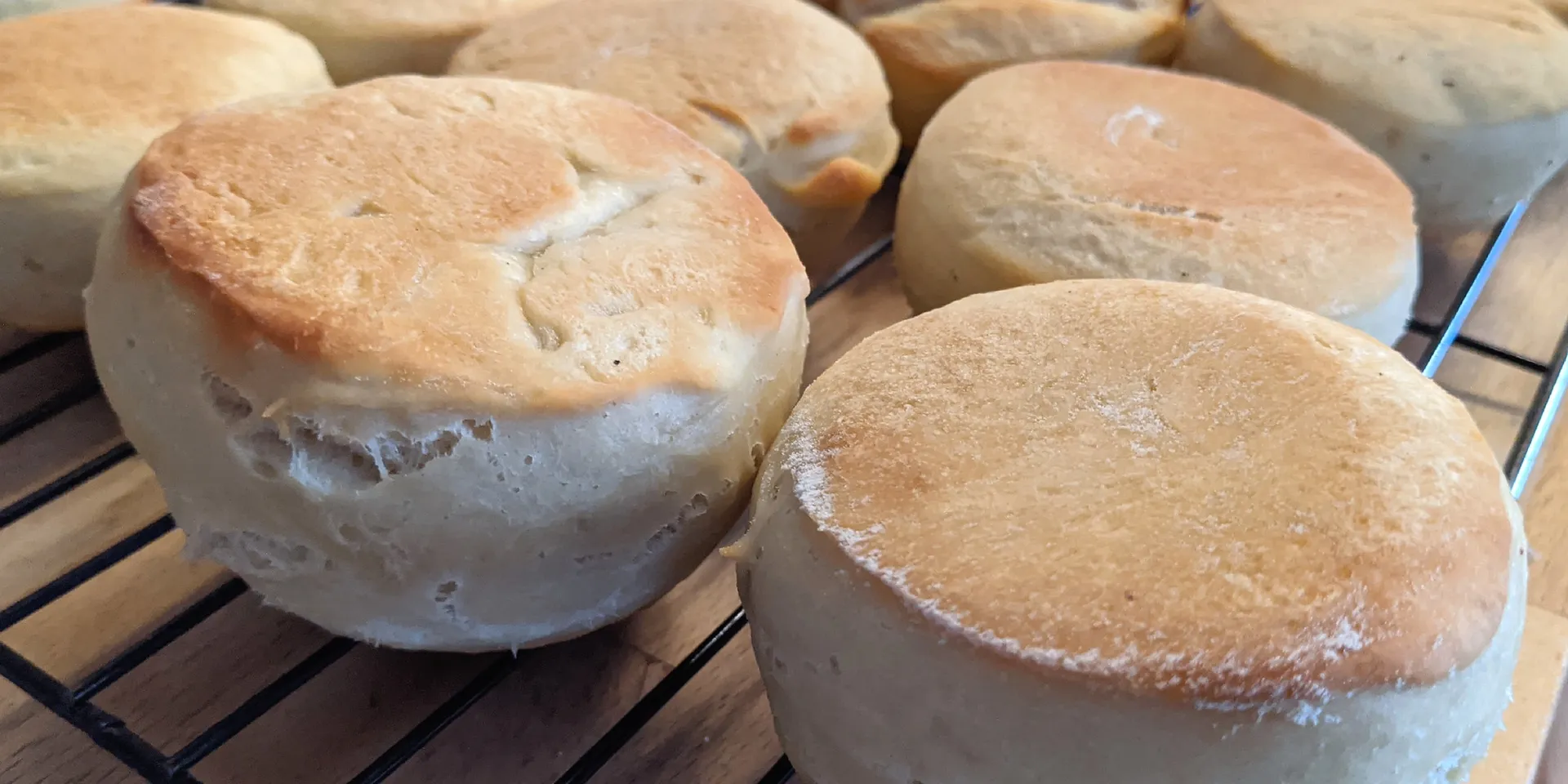English muffins are a type of yeasted bread that is cooked on a griddle or in a frying pan. They are usually round and flat, and have a crumb that is riddled with large holes. English muffins are often served split open and toasted, with butter or margarine spread on top.
What are English Muffins?
Updated:

"Homemade sourdough English muffins" by Ruth and Dave is licensed under CC BY 2.0. To view a copy of this license, visit https://creativecommons.org/licenses/by/2.0/?ref=openverse.
Table of Contents
The History of English Muffins
Ingredients in English Muffins
Contrary to its name, the English Muffin is not, in fact, English. They are largely credited to Samuel Bath Thomas. Thomas, whose name now graces the package of English Muffins in supermarkets everywhere, hailed from England but immigrated to the states in the 19th century.
In 1880, Samuel opened a bakery in New York City. He began selling his so-called English Muffins, made using his mother’s recipe, to grocery stores and hotels. Soon, English Muffins began spreading across the country.
The soft, springy muffin was a hit. The English Muffin is most famous for its muffin-like texture and its fork-split, which allows the muffin to be split in half easily for the addition of toppings.
The English Muffin has evolved to be made from yeast-leavened whole-wheat and white flours, and is similar to the crumpet in that they are fried, not baked. The English Muffin is usually served with honey, butter, or jams.
You might not find it surprising to find out that the English Muffin is simply referred to as a muffin.
The History of English Muffins
Despite its name, the English Muffin does not come from England. There are references to such muffins in American literature from as far back as 1859, but the English Muffin did not attain popularity until the arrival of an English immigrant named Samuel Bath Thomas.
Samuel Bath Thomas, a British ex-patriot, immigrated to New York City in 1872. In 1880, Thomas opened his bakery located in Chelsea and began baking his mother’s recipes for the world to enjoy. One such recipe was his mother’s English muffin dough.
Thomas sold his spongy, soft muffins to stores and hotels in the area. Thomas’ muffins had a convenient fork-split that made tearing and toasting them easier than with traditional muffins. He soon had enough patrons to open a second bakery called “The Muffin House.”
The English Muffin was first recognized by the Merriam-Webster dictionary in 1902. Thomas trademarked the name in 1926. The Thomas name remains branded on store-bought English muffins to this day.
In the 1940s, a West-Coast contender to the English Muffin throne arrived on the scene. Foster’s, a restaurant in San Francisco, trademarked and began mass-producing their sourdough variation of the English Muffin.
Ironically, the English Muffin was largely unknown to England until the 1990s when Thomas’ brand arrived across the pond. The British call the English muffins American muffins, American-styled muffins, or sweet muffins.
Ingredients in English Muffins
The common ingredients in most English muffin recipes are as follows:
- Wheat Flour
- Butter
- Milk
- Sugar
- Salt
- Baker's Yeast
English Muffin Nutritional Information
English muffins are a fairly low-calorie bread, with an average muffin having just about 100 calories per serving. However, being that the muffin itself consists mainly of refined wheat flour, it does not have any large amounts of fiber or complex carbs.
English muffins are not particularly unhealthy, but they do not provide much by way of vitamins or minerals unless whole-wheat or enriched flour variations are used.
But, all things considered, there are many less-healthy types of bread out there, and when paired with a protein or healthy fats, English muffins can be a good source of carbs and niacin.
How to Make English Muffins
English muffins are fairly simple to make and not too time-consuming. Many recipes require the use of scalded and cooled milk. You can make scalded milk by heating it until a skin forms on the surface of the milk and removing it from the heat before it comes to a boil.
You start making the English muffin mix by mixing all of the ingredients together excluding the flour. Once you have mixed the other ingredients together, you slowly add the flour to the mixture, mixing until the dough is satiny-smooth and stretchy in texture.
English muffins undergo two separate proofing processes. The first occurs after the dough has formed and lasts for one to two hours. The second proof lasts only about thirty minutes.
You baked the English muffins on the stovetop at low heat, flipping them every few minutes until browned evenly on both sides.
English Muffin Recipes
The English muffin is a classic recipe, but many popular variations have sprung up over the years.
You can make yourself a classic English muffin recipe a-la-Thomas by using traditional wheat flour. If you want to give sourdough English muffins a try, you’ll need to use a sourdough starter with your wheat flour.
If you have more of a sweet tooth, adding honey to your traditional mixture will sweeten the dough. Or, for a newer twist, try adding cinnamon and raisins to your dough before the final proof.
Quite a few popular variations include changing up the topping served with the muffins. The classic eggs Benedict with hollandaise sauce remains popular today, as well as the traditional toppings of butter, honey, and jam.
There are conflicting stories about how English muffins got their name. One theory is that they were invented in England in the 18th century and brought over to the United States by english settlers. Another theory is that the word "English" simply refers to the fact that they are a type of bread (as opposed to a cake or biscuit).
Over in the UK these muffins can sometimes be called a Breakfast muffin or just plainly Muffin. You might imagine these to have been called a crumpet or a scone, but these are completely different bread items
No! They were however created in New York, USA by and Englishman named Samuel Bath Thomas who coined that name after using his Mothers recipe back in in 1880
Yes, English muffins do have yeast to help with a bit of a rise when they hit the pan to be fried and gain that typical muffin bottom.
They are called English muffins because they were invented by an Englishman in the 1800s.
The main difference between English muffins and regular muffins is that English muffins are made with a yeast-based dough, while regular muffins are made with a batter. This results in English muffins having a denser, chewier texture, while regular muffins are typically lighter and airier. English muffins also have a distinctly crispy crust, due to the fact that they are cooked on a griddle or in a frying pan.
Yes, English muffins can be frozen. To do so, wrap them tightly in plastic wrap or place them in a freezer bag. They will keep for up to 3 months in the freezer.
English muffins will last for about 2-3 days when stored at room temperature. If you want them to last longer, you can store them in the refrigerator, where they will keep for up to 1 week.
Yes, English muffins can be reheated. To do so, place them on a baking sheet and warm them in a 350 degree oven until they are heated through. You can also reheat english muffins in the microwave, although this will result in a less crispy texture.
There are a few different ways to split an English muffin. The easiest way is to simply use your hands to gently pull the muffin apart. You can also use a knife to cut through the center of the muffin, or you can use a fork to poke holes all around the edge of the muffin and then pull it apart.
To toast an English muffin, place it on a baking sheet and cook it in a 350 degree oven for about 5-7 minutes, or until it is golden brown and crispy. You can also toast English muffins in a toaster or under the broiler.
There are many different ways to enjoy English muffins. They can be split open and eaten plain, or they can be topped with butter, margarine, jelly, or honey. English muffins can also be used as the base for sandwiches, such as egg and cheese sandwiches or bacon, lettuce, and tomato sandwiches.
English muffins are sold in most supermarkets and speciality food stores. You can also purchase them online from a variety of retailers.
The price of English muffins varies depending on the brand and where you purchase them. However, they typically range in price from $2-$4 per muffin.
In addition to the methods already mentioned, English muffins can also be grilled, used as the base for a savory strata or quiche, or even crumbled and used in place of breadcrumbs.
A single English muffin typically contains around 200-250 calories. However, this number will vary depending on the brand and the ingredients used.
Yes, English muffins can be part of a healthy diet. They are a good source of complex carbohydrates and fiber, and they contain no saturated fat or cholesterol.
One English muffin contains about 200-250 calories, depending on the brand. They are a good source of complex carbohydrates and fiber, and they contain no saturated fat or cholesterol.
One English muffin contains about 30 grams of carbohydrates.
One English muffin typically contains around 5 grams of protein. However, this number will vary depending on the brand and ingredients used.
The glycemic index (GI) of an English muffin depends on the ingredients used, but typically ranges from 50-70.
An English muffin is a type of yeast bread that is cooked on a griddle or in a toaster oven. English muffins are typically round and flat, with a slightly chewy texture. Regular muffins, on the other hand, are made with baking powder or soda and are cooked in a standard oven. They are often sweeter than English muffins and have a cake-like texture.
Yes, English muffins can be vegan. There are many brands that offer vegan English muffins made with non-dairy milk and vegetable shortening.
